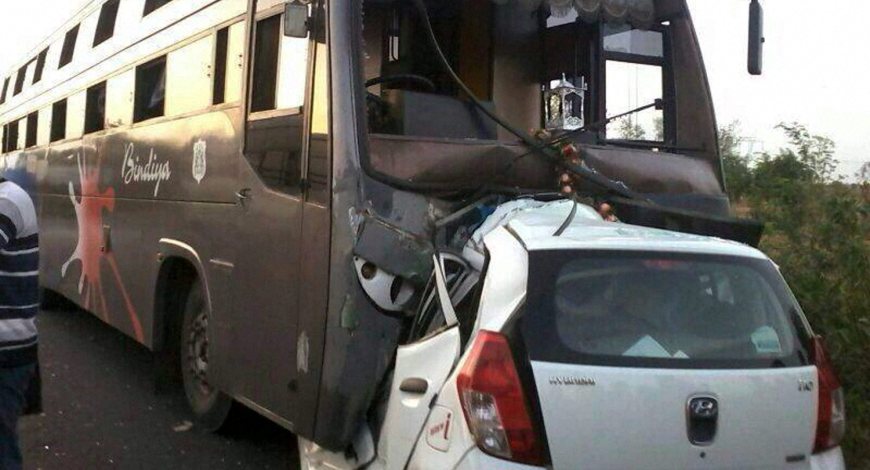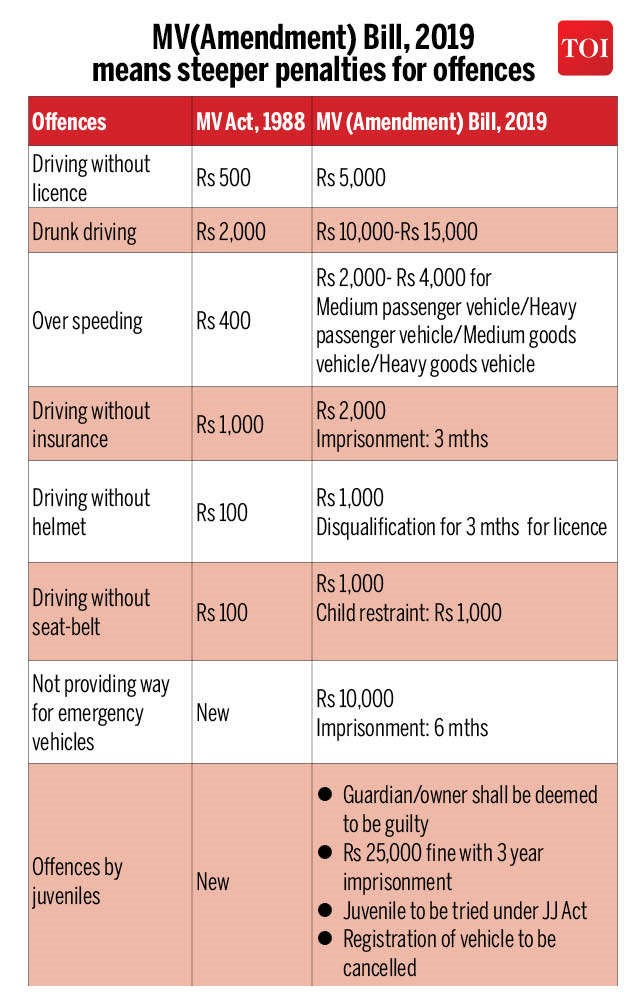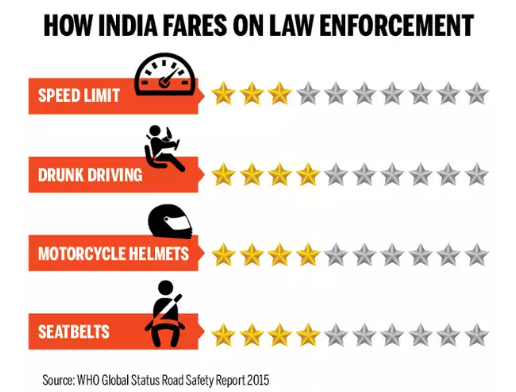Description

Disclaimer: Copyright infringement not intended.
Context
- India has a dubious distinction of registering the highest number of casualties in road accidents- Government.
Road accidents in India
- India ranks first in the number of road accident deaths across the 199 countries.
- With only 1 per cent of the world's vehicles, India accounts for 11 per cent of the global death in road accidents, the highest in the world, according to World Bank.
- Witnessing 53 road crashes every hour; road accidents are killing 1 person every 4 minutes.
- The country accounts for about 4.5 lakh road crashes per annum, in which 1.5 lakh people die.
- In the last decade, 13 lakh people died and another 50 lakh got injured on Indian roads.The 2019 World Bank report, titled 'Guide for Road Safety Opportunities and Challenges: Low- and Middle-Income Countries Country Profiles', puts the road crash and serious injury cost estimate at 7.5 per cent of India's GDP or Rs 12.9 lakh crore for 2016.
Reasons behind Road Accidents in India
The major reasons that cause accidents in India are:
- Crossing the speed limit: Over speeding is one of the major causes of road accidents in India.
- Intoxication - Driving under the influence of heavy medication, alcohol, or drugs is another major reason for road accidents in the country. Any driver found with more than 30 mg of alcohol in 100 ml of blood is under the influence of alcohol and is a culprit of drunk driving.
- Reckless driving - Reckless driving includes over-confidence, street racing, running stop signs and red lights, changing lanes too quickly, tailgating the vehicle in the front, and hurling abuses at other drivers on the road.
- Not following rules and regulations on the road: Being unaware of rules and regulations on the road or knowingly ignoring them is another major cause of road accidents in India.
- Deplorable conditions of the road: Despite the vast network of roads in the country, most of them have potholes, without road signs or under construction for a long period. All these lead to road accidents.
- State of the vehicle: Many vehicles in India are not fit enough to operate on the roads in India. For instance, a vehicle may operate on the road without proper tyres, the vehicle may be overloaded or it might not be repaired.
- Distracted Driving: The number of accidents occurring due to distracted driving has increased in the past decades. Reading messages, replying to texts, taking calls, reading, grooming, etc.
- Avoiding Safety Gears like seat belts and helmets.
|
Justice Radhakrishnan committee:
➢ It has pointed out serious lapses in implementation of safety laws by States, which has led to increasing number of road fatalities.
➢ It asked the State governments to formulate their respective State Road Safety policies besides setting up State Road Safety Councils.
➢ States have to draw up a protocol to identify black spots on their roads and their removal.
➢ The committee directed the States to strengthen enforcement on drunken driving, over speeding, red light jumping and helmet and seat belt laws.
➢ Other directions include, tightening of road patrols on highways, establishment of road safety fund to which a portion of traffic fines collected would go to finance road safety expenses and remove encroachments on pedestrian paths, among others.
|
Steps taken to prevent Road Accidents
Motor Vehicle Amendment Act and its Provisions:
- A major initiative of the Ministry in the field of Road Safety has been the passing of the Motor Vehicle Amendment Bill 2019:
[Vehicle Fitness]
- Automated fitness testing for vehicles has been made mandatory under MVA. This would reduce corruption in the transport department while improving the road worthiness of the vehicle.
[Recall of Vehicles]
- The Act allows the central government to order for recall of motor vehicles if a defect in the vehicle may cause damage to the environment, or the driver, or other road users. The manufacturer of the recalled vehicle will be required to:
- reimburse the buyers for the full cost of the vehicle, or
- replace the defective vehicle with another vehicle with similar or better specifications.
[Penalties]

[Road Safety Board]
- A National Road Safety Board, to be created by the central government through a notification to advise the central and state governments on all aspects of road safety and traffic management including –
- standards of motor vehicles,
- registration and licensing of vehicles,
- standards for road safety, and
- promotion of new vehicle technology.
Education and Awareness
- Observance of National Road Safety Month/Week every year for spreading awareness and strengthening road safety.
- A Certification Course for Road Safety Auditors has been commenced in Indian Academy of Highway Engineers (IAHE).
- For the first time, the Government of India celebrated the “Road Safety Month – 2021” with the themes: Sadak Suraksha- Jeevan Raksha to increase awareness about road safety.
Engineering (both of Roads and vehicles)
- Ministry has identified black spots (accident prone spots) on National Highways based on accident and fatality data and rectified many of them.
- Guidelines for pedestrian facilities on National Highways for persons with disabilities have also been issued to all States / UTs.
- Ministry has notified fitment of Speed Limiting devices on all transport vehicles.
- Scheme for setting up one model Inspection & Certification Centre in each State/UT.
National Road Safety Policy
- This Policy outlines various policy measures such as promoting awareness, establishing road safety information data base, encouraging safer road infrastructure including application of intelligent transport, enforcement of safety laws etc.
National Road Safety Council
- An apex body to take policy decisions in matters of road safety.
4 Es
- Multi-pronged strategy to address the issue of road safety based on 4 ‘E’s viz. Education, Engineering (both of roads and vehicles), Enforcement and Emergency Care.
Model Driving Training Institutes
- Setting up of model driving training institutes in States.
Tightening of safety standards
- Tightening of safety standards for vehicles like Seat Belts, anti-lock braking system etc.
Road Safety Engineering Workshops
- National Level Workshops and several Regional Training workshops in various states have been organized on Road Safety Engineering.
|
2030 Agenda for Sustainable Development:
➢ Target 3.6: pledges to halve by 2020 “the number of global deaths and injuries from road traffic accidents”.
➢ Target 11.2: calls on providing, by 2030, “access to safe, affordable, accessible and sustainable transport systems for all, improving road safety”.
➢ Target 9.1: calls for developing “quality, reliable, sustainable and resilient infrastructure”, including through investments in transport infrastructure.
➢ The goals represent strong international road safety commitments and a renewed momentum for the Decade of Action for Road Safety 2011-2020.
|
Way Ahead
- Road safety education from the primary level. Including "Road Safety" in the school syllabus.
- Stricter exams and practical tests for driving licenses.
- Better road design, maintenance and signage.
- Crackdown on driving under influence of alcohol and drugs.
- Bystander Training Programme should be undertaken in a time-bound manner.
- Enforcement of traffic rules: The Amended Motor Vehicles Act has higher penalties and punishment to deter people from committing traffic offences and driving rashly. But States have been lukewarm towards hard steps to bring order to the roads, viewing zero tolerance rule enforcement through the lens of populism. It is still far away from being implemented or enforced properly on a national level.
- Encouraging better road behavior: Hyundai has been running a very educative and innovative campaign "Be the Better Guy", with some of the advertisements and films even featuring superstar Shahrukh Khan. Such campaigns that urge people to behave in a better manner on the road and "Be the Better Guy", need to be applauded, encouraged and expanded.
- Better law enforcement: In India, though the law is in place, its enforcement and communication is weak.

- Enforcement of all road safety laws needs to be improved. Enforcement efforts must be well-publicized, sustained, and implemented through the use of appropriate measures and penalties for infringement.
- Only with high political will — and there is no evidence this is present in all the States — we can hope of ending the “silent pandemic” of accidents that will need education, civil society cooperation and professional policing.
INTERNATIONAL ROAD SAFETY CONVENTIONS
Brasilia Declaration
- The Brasilia Declaration, adopted at the second global high-level conference on road safety held in Brazil, lays down recommendations on strengthening existing legislations, adopting sustainable transport and strengthening post-crash response.
- In the declaration, participants reasserted their commitment to reduce the deaths caused due to traffic accidents to half by the year 2020. This target was set under the 2030 Agenda for Sustainable Development.
Stockholm Declaration
- Known as the "Stockholm Declaration", this seminal commitment to address the 1.3 million lives lost every year on the world's roads, and the tens of millions who are seriously injured, was agreed by some 1 700 delegates from around 140 countries.
International Road Assessment Programme (iRAP)
- The International Road Assessment Programme (iRAP) is a registered charity dedicated to saving lives by eliminating high risk roads throughout the world.
- iRAP works in partnership with governments, road authorities, mobility clubs, development banks, NGOs and research organisations to:
- Inspect high-risk roads and develop Star Ratings, Risk Maps and Safer Roads Investment Plans
- Provide training, technology and support that will build and sustain national, regional and local capability
- Track road safety performance so that funding agencies can assess the benefits of their investments.
- iRAP’s Plan is aligned to the Global Plan for the Decade of Action launched in October 2021.
United Nations Road Safety Collaboration
- Established in 2004, the UNRSC is an informal consultative mechanism whose goal is to facilitate international cooperation and strengthen global and regional coordination among UN agencies and other international partners to implement UN General Assembly Resolutions on road safety.
https://indianexpress.com/article/india/gadkari-soon-rs-7500-crore-scheme-to-reduce-road-mishaps-7823487/















